IMEHA (International Model Equine Hobbyists Association) was an online photo showing site that existing until 2018. Included on the site were these guidebooks for judging and showing model horses in Performance classes. MEPSA has obtained permission to share the info contained in the guides.
Scoring :: Point Deducts :: Tack :: Rider :: Reins :: Set-Up Options :: Photo Examples
This class is seen only in the model horse hobby. It is written for those people who wish to compete in trail class but do not have arena wall props. Some rulings, attire and equipment may be relaxed slightly. Natural trail classes are judged under the same rules and with the same requirements as Arena Trail but are held outside of the arena using natural obstacles such as creeks, ponds, uphill and downhills slopes, ditches fallen trees, bushes, pasture gates, etc. The natural trail class should be judged on realism, imagination, and the horse’s apparent ability to provide a safe and pleasurable ride. Any tack and any attire permitted; curb bits should include straps, saddles should have girths. Unsafe equipment may be penalized at the judge’s decision. Any misbehavior should be penalized, including but not limited to shying, bucking, rearing, fighting the bridle, being above the bit, jumping or leaping away of the obstacle.
A horse should demonstrate a willing walk and calmly work over and through all obstacles, showing agility, in control of the rider and on the bit, balance, and ready responsiveness. Horses that shy, pace, above the bridle or otherwise demonstrating excitement or lack of control are not suitable for arena trail. A trail horse should, however, not be a dead head but should show interest in the obstacles. A trail obstacle represents a test and the horse is judged on how well it is meeting that test. The obstacle may test calmness, agility or control. All obstacles test willingness and obedience. Credit will be given to horses negotiating the obstacles with style and some degree of speed, providing correctness is not sacrificed. Horses should receive credit for showing attentiveness to the obstacles and the capability of picking their own way through the course when obstacles warrant it, and willingly responding to the rider’s cues on more difficult obstacles. Gaits are halt, walk, jog, lope and back.
No cross entering using the same photo for both Western Natural Trail and Western Pleasure Natural. Natural Trail requires an obstacle and Natural Pleasure should have no obstacle in the photo. No cross entering from Trail Trial.
For additional helpful hints for Western Pleasure or other disciplines please check out Susan Hargrove’s site at: Oh Joy Farms.
You Score Western Trail Natural on the following basis:
Obstacles:
Creeks
Ponds
Uphill and downhills slopes
Ditches
Fallen Trees
Bushes
Pasture Gates
Tires
Animal Contact
Dismounting
Jumps
Rocking, moving or railed bridges
Water box with floating or moving parts
Ground ties
Any other type natural obstacle or experience outside of an arena
Extra Credit Should Be Given If:
(1) Split reins are used, the rein should fall on the same side as the rein hand.
(2) A romal rein is used; romal should fall on the opposite side from the rein hand (romal is usually held in the rider’s other hand).
(3) Any imagination in obstacle designed.
Points Should Be Deducted If:
(1) Model penalized for any unnecessary delay while approaching or negotiating the obstacles.
(2) Models with artificial appearance over obstacles should be penalized.
(3) Model has front or hind feet in a single-strided slot or space at a walk or jog.
(4) Model skipping over or failing to step into required space.
(5) Model shows an incorrect number of strides, if specified.
(6) Model showing a blatant disobedience including shying, backing, kicking out, bucking, rearing, or striking.
(7) Model is on the wrong lead.
(8) Model exhibits excessive speed for gait assigned.
(9) Model appears to display a slowness in any gait or loss of forward momentum resulting in an animated and/or artificial gait at the lope.
(10) Model displays excessive nosing out.
(11) Model displays an opening mouth excessively.
(12) Model appears sullen, dull, lethargic, emaciated, drawn or overly tired.
(13) Model appears agitated has ears back, tail twirled, etc.
(14) Rider uses spurs forward of the cinch.
(15) Rider has reins draped to the point that light contact is not maintained.
Required Tack:
A western stock saddle without tapaderos. The saddle can have either squared or rounded skirts with the current style leaning toward squared. In most breeds the current style also is to omit the rear cinch, sometimes adding “tabs” to occupy the rear girth slots; however, if a rear cinch is used, it must have a connecter strap to the front cinch. Breastplates are optional. Silver should not be counted over a good working outfit. A saddle pad resting under all pressure points is recommended but not required equipment. A western style bridle (browband, one ear, two ear, with or without throatlatch) with a curb bit including a curb strap or curb chain. Standard snaffle bit and bosal hackamores are permitted on horses 4 and under (5 and under for Arabians and Appaloosas). Romal reins and split reins are both legal; Romal reins are usually seen on Arabians, Morgans, and NSH. Missouri Fox Trotters usually wear a noseband and current style includes older buckstitched saddle. MFT current style saddle pads are white with white ribbon in mane and forelock.
Prohibited Tack:
Nosebands or cavessons (except: Missouri Fox Trotter and National Spotted Saddlebred/Walking Horse). any type of martingale or tiedown, tapaderos, roping reins, any kind of boots or bandages, crops or whips, mechanical hackamores are also prohibited. Split reins may not be knotted or attached to each other (stick wax is of course permitted in model horses) Rider may not have more than one finger between split reins or any fingers between the reins of a rein and romal.
Rider:
Attire is jeans, trousers or pants over western boots, long sleeved shirts, (vest, tie and jacket are also permitted) belt through loop, and western hat. Chaps are not required but should not be discounted if used. The doll rider’s posture must be addressed because if you can’t get it correctly then don’t use it. Doll must sit down in the saddle, the back should be straight. There should be a straight vertical line between the rider’s ear, the elbow and the heel. The knee and toe of the boot should also be in a straight line, knees and feet turned straight along the side of the horse and heel of boot pointed down. The rein arm upper arm should be tucked into the side of the rider, elbow is bent and the forearm parallel to the ground. The free arm is held free and straight down with palm flat and lightly touching the leg. You may place ONE finger between your split reins and there is no rule as to which one – though most riders place their index finger between. If using romal reins the romal hand is carried with hand holding romal at the length of which the romal is straight and not curved. Hand then rest quietly near or on the doll’s leg. Hackamore or snaffle reins the riders hands should be carried near the pommel and not further than four inches (to scale) out on either side of the saddle horn. Rein hand wrist(s) of either rein is turned slightly inward. The doll rider’s head should be looking straight forward as if rider is looking through the horse’s ears.
Rein Hand Holds:
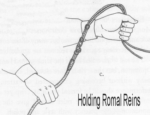

Rein Pull:
Horses are shown on a reasonable loose rein. Extremes such as too tight or too loose should be penalized.



Set-Up Options:
No arena railings allowed.
Obstacle required
Footing Required:
- Dirt
- Sand
- No grass base
- No rock base
Backboard or Natural Setting (Indoor or Outdoor)
Examples of the Four Breed Divisions:
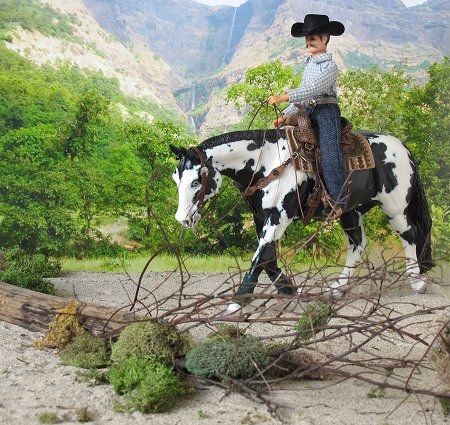
Western Trail Natural
Stock Breed Entry
Adrenna Lynn, shown as a Black Overo Paint Mare. Mold is a Smokin HotChic by Clayton Comment Line reads: While riding in the canyon, horse and rider encounter some deadfall left by a recent flood. The deadfall is low enough to be easily jumped. Entry is owned by Andrea Robbins.
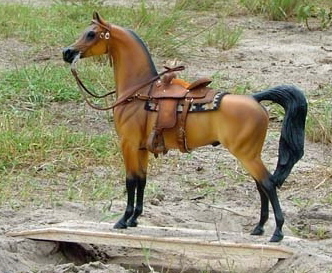
Western Trail Natural
Arabian Breed Entry
Alimah Bey shown as a Bay Arabian Gelding. Mold is a PS Arabian. Comment Line reads: Bey halts on the bridge walkover to demonstrate the patience and quietness of the Arabian breed on a natural trail course. Shown by Veronica Geddie.

Western Trail Natural
TB/WB or Sporthorse Breed Entry
Leopard Rock shown as a Black Semi-leopard Appaloosa Sport Horse (Hanoverian x Appaloosa) gelding. Mold is a CM Breyer Show Jumping Warm blood – Ideal. Shown by Andrea Robbins. Comment Line reads: Horse and rider come upon a fallen tree to jump as they ride through the red rock canyon.

Western Trail Natural
Other Breed Entry
Violet shown as a Red Roan Molly Mule. Mold is a Ltd. Ed. ceramic casting by J. Brent-Starr. Comment Line reads Violet doesn’t spook as she and her rider come upon a young woman photographing model horses. What a strange hobby! Props, tack, dolls, photo by K. Jacobs.
Hold the Reins Correctly:
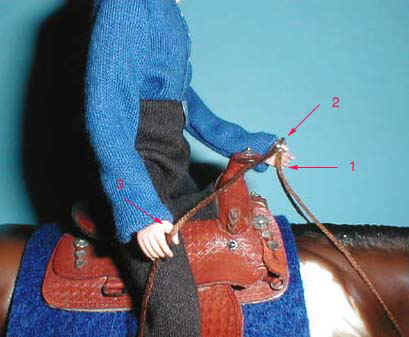
Romal Reins by Susan Hargrove
Romal reins enter the hand by the “little” finger lay across the palm of the hand and exit the hand on top over the thumb. The hand holds the reins and not the loop and knot that form the junction of the reins and the romal whip.
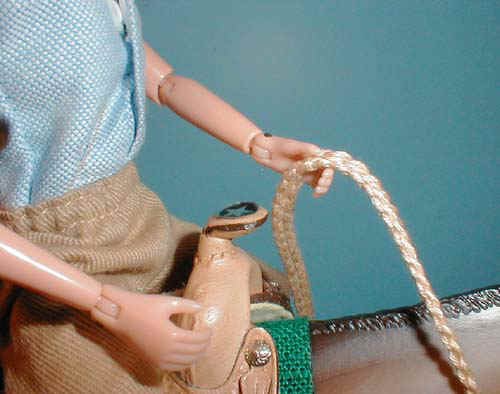
Split Reins by Susan Hargrove
Split reins can be held in the right or left hand. The excess rein hang over untouched on the same side of the horse. So if right hand hold the rein then the excess rein lies on the right side of the horse. If left hand holds the rein then the excess rein lies on the left side of the horse. Split reins enter the hand via coming straight into the hand over the index finger and they exit by the little finger.

Snaffle Reins by Susan Hargrove
The snaffle rein crosses over the horse’s neck with the bight extending down ward on the opposite side of the horse’s neck. Both hands are used on the reins by picking the rein and the bight up with the palms of the hands facing down.
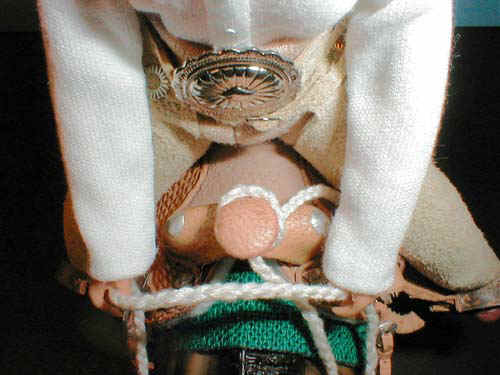
Hackamore Mecate Reins by Susan Hargrove
The hackamore mecate rein is a solid single loop rein with the bight tied from the bosal to either the saddle horn or coiled and tied to the front piggin string (or swell string) of the saddle. Both hands are used on the rein by picking the rein with the palms of the hands facing down.
